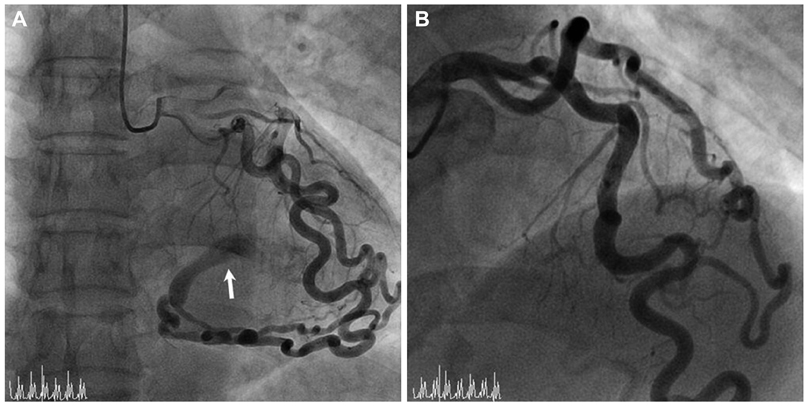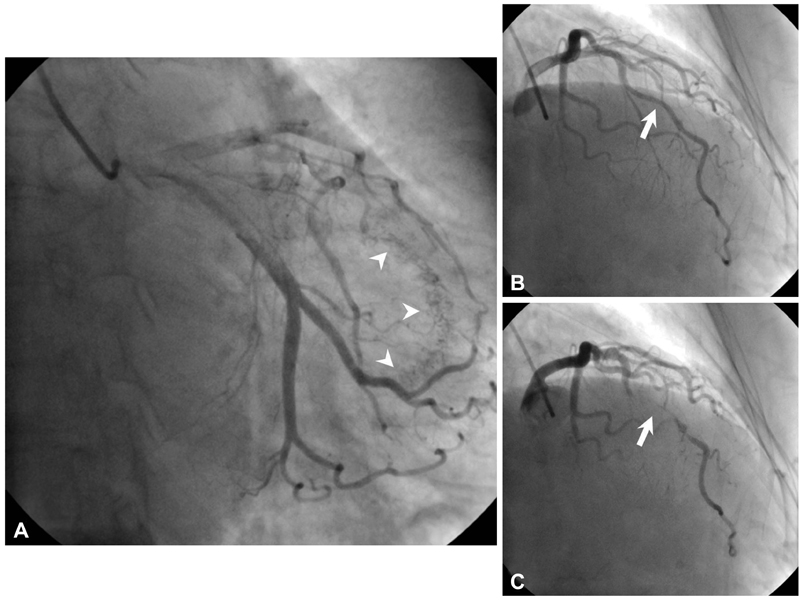Korean Circ J.
2012 Dec;42(12):845-848. 10.4070/kcj.2012.42.12.845.
Hemodynamic Significance of Coronary Cameral Fistula Assessed by Fractional Flow Reserve
- Affiliations
-
- 1Department of Cardiology, Medical Research Institute, Pusan National University Hospital, Busan, Korea. cks@pusan.ac.kr
- KMID: 1491101
- DOI: http://doi.org/10.4070/kcj.2012.42.12.845
Abstract
- Coronary cameral fistula (CCF) is a rare anomaly, where a communication exists between an epicardial coronary artery and a cardiac chamber. Assessing the hemodynamic significance of the fistula is crucial to make a decision concerning the management process. We present two cases of CCF, draining into the left ventricle, in which the hemodynamic significance was assessed by a fractional flow reserve.
MeSH Terms
Figure
Reference
-
1. Sapin P, Frantz E, Jain A, Nichols TC, Dehmer GJ. Coronary artery fistula: an abnormality affecting all age groups. Medicine (Baltimore). 1990. 69:101–113.2. Rana O, Swallow R, Senior R, Greaves K. Detection of myocardial ischaemia caused by coronary artery-left ventricular fistulae using myocardial contrast echocardiography. Eur J Echocardiogr. 2009. 10:175–177.3. Strange JW, Bucciarelli-Ducci C, Mathur A, Pennell DJ. Images in cardiovascular medicine. Multiple coronary fistulae: a cause of subendocardial ischemia. Circulation. 2008. 117:853–856.4. Vavuranakis M, Bush CA, Boudoulas H. Coronary artery fistulas in adults: incidence, angiographic characteristics, natural history. Cathet Cardiovasc Diagn. 1995. 35:116–120.5. Levin DC, Fellows KE, Abrams HL. Hemodynamically significant primary anomalies of the coronary arteries: angiographic aspects. Circulation. 1978. 58:25–34.6. Liberthson RR, Sagar K, Berkoben JP, Weintraub RM, Levine FH. Congenital coronary arteriovenous fistula: report of 13 patients, review of the literature and delineation of management. Circulation. 1979. 59:849–854.7. Armsby LR, Keane JF, Sherwood MC, Forbess JM, Perry SB, Lock JE. Management of coronary artery fistulae: patient selection and results of transcatheter closure. J Am Coll Cardiol. 2002. 39:1026–1032.8. Bamoshmoosh M, Marraccini P, Pratali L, Ciriello G, Ciardetti M, Mazzarisi A. "Reverse steal phenomenon" in a patient with coronary artery disease and coronary-left ventricular fistula. Int J Cardiol. 2007. 115:e33–e35.9. Escaned J, Cortés J, Flores A, et al. Importance of diastolic fractional flow reserve and dobutamine challenge in physiologic assessment of myocardial bridging. J Am Coll Cardiol. 2003. 42:226–233.
- Full Text Links
- Actions
-
Cited
- CITED
-
- Close
- Share
- Similar articles
-
- Funtional significance of the intermediate lesion in a single coronary artery assessed by fractional flow reserve
- Fractional Flow Reserve: The Past, Present and Future
- Coronary Cameral Fistula and Anomalous Right Coronary Artery: A Case Report
- Beyond Coronary CT Angiography: CT Fractional Flow Reserve and Perfusion
- Role of Pressure Wire in Coronary Artery Disease





